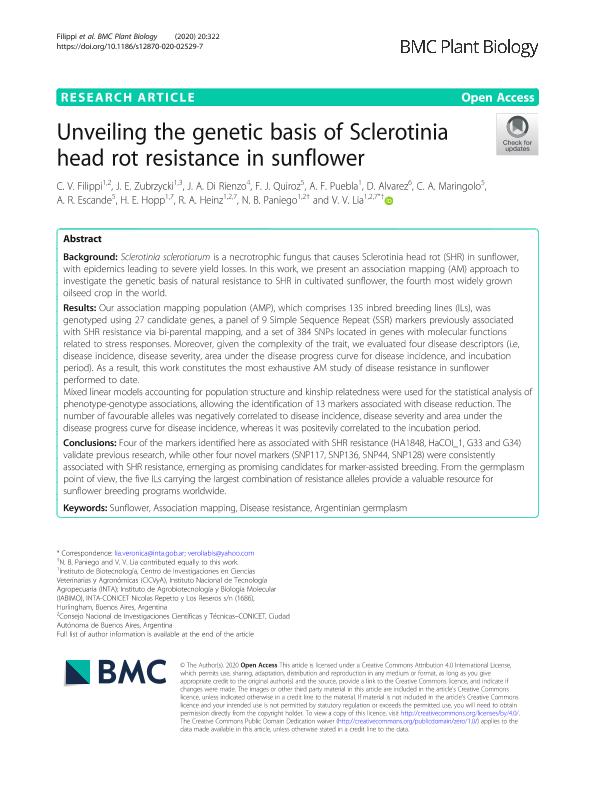Artículo
Unveiling the genetic basis of Sclerotinia head rot resistance in sunflower
Filippi, Carla Valeria ; Zubrzycki, Jeremías Enrique
; Zubrzycki, Jeremías Enrique ; Di Rienzo, Julio Alejandro; Quiroz, Facundo José; Puebla, Andrea Fabiana; Alvarez, D.; Maringolo, C. A.; Escande, Alberto Raul; Hopp, Horacio Esteban; Heinz, Ruth Amelia
; Di Rienzo, Julio Alejandro; Quiroz, Facundo José; Puebla, Andrea Fabiana; Alvarez, D.; Maringolo, C. A.; Escande, Alberto Raul; Hopp, Horacio Esteban; Heinz, Ruth Amelia ; Paniego, Norma Beatriz
; Paniego, Norma Beatriz ; Lia, Veronica Viviana
; Lia, Veronica Viviana
 ; Zubrzycki, Jeremías Enrique
; Zubrzycki, Jeremías Enrique ; Di Rienzo, Julio Alejandro; Quiroz, Facundo José; Puebla, Andrea Fabiana; Alvarez, D.; Maringolo, C. A.; Escande, Alberto Raul; Hopp, Horacio Esteban; Heinz, Ruth Amelia
; Di Rienzo, Julio Alejandro; Quiroz, Facundo José; Puebla, Andrea Fabiana; Alvarez, D.; Maringolo, C. A.; Escande, Alberto Raul; Hopp, Horacio Esteban; Heinz, Ruth Amelia ; Paniego, Norma Beatriz
; Paniego, Norma Beatriz ; Lia, Veronica Viviana
; Lia, Veronica Viviana
Fecha de publicación:
07/2020
Editorial:
BioMed Central
Revista:
BMC Plant Biology
ISSN:
1471-2229
Idioma:
Inglés
Tipo de recurso:
Artículo publicado
Clasificación temática:
Resumen
Background: Sclerotinia sclerotiorum is a necrotrophic fungus that causes Sclerotinia head rot (SHR) in sunflower, with epidemics leading to severe yield losses. In this work, we present an association mapping (AM) approach to investigate the genetic basis of natural resistance to SHR in cultivated sunflower, the fourth most widely grown oilseed crop in the world. Results: Our association mapping population (AMP), which comprises 135 inbred breeding lines (ILs), was genotyped using 27 candidate genes, a panel of 9 Simple Sequence Repeat (SSR) markers previously associated with SHR resistance via bi-parental mapping, and a set of 384 SNPs located in genes with molecular functions related to stress responses. Moreover, given the complexity of the trait, we evaluated four disease descriptors (i.e, disease incidence, disease severity, area under the disease progress curve for disease incidence, and incubation period). As a result, this work constitutes the most exhaustive AM study of disease resistance in sunflower performed to date. Mixed linear models accounting for population structure and kinship relatedness were used for the statistical analysis of phenotype-genotype associations, allowing the identification of 13 markers associated with disease reduction. The number of favourable alleles was negatively correlated to disease incidence, disease severity and area under the disease progress curve for disease incidence, whereas it was positevily correlated to the incubation period. Conclusions: Four of the markers identified here as associated with SHR resistance (HA1848, HaCOI_1, G33 and G34) validate previous research, while other four novel markers (SNP117, SNP136, SNP44, SNP128) were consistently associated with SHR resistance, emerging as promising candidates for marker-assisted breeding. From the germplasm point of view, the five ILs carrying the largest combination of resistance alleles provide a valuable resource for sunflower breeding programs worldwide.
Palabras clave:
ARGENTINIAN GERMPLASM
,
ASSOCIATION MAPPING
,
DISEASE RESISTANCE
,
SUNFLOWER
Archivos asociados
Licencia
Identificadores
Colecciones
Articulos (IABIMO)
Articulos de INSTITUTO DE AGROBIOTECNOLOGIA Y BIOLOGIA MOLECULAR
Articulos de INSTITUTO DE AGROBIOTECNOLOGIA Y BIOLOGIA MOLECULAR
Citación
Filippi, Carla Valeria; Zubrzycki, Jeremías Enrique; Di Rienzo, Julio Alejandro; Quiroz, Facundo José; Puebla, Andrea Fabiana; et al.; Unveiling the genetic basis of Sclerotinia head rot resistance in sunflower; BioMed Central; BMC Plant Biology; 20; 1; 7-2020; 1-13
Compartir
Altmétricas



